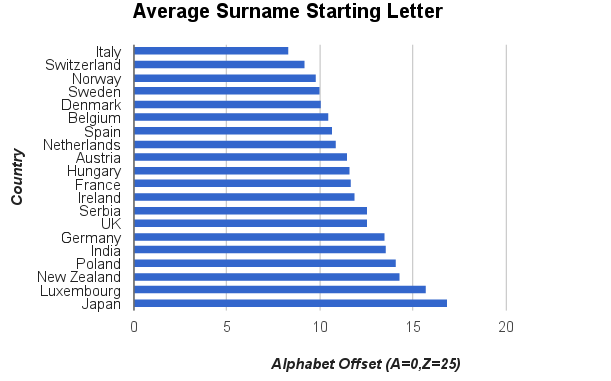2013-11-03 Sun
data passwords
One can spend an endless amount of time slicing the adobe data up. Here's a list of the most common gov addresses in it. Team NASA for the win. It'd be interesting to see how corporate policies affect how often employees wind up registering with a site like adobe.

Does alphabetical order push some cultures to the back of the bus? This week Livermore had its annual summer reading program award ceremony, where every reader got to shake hands with the city council. Just like last year, they lined up everyone in alphabetical order and jumbled all the grades together. They made us all show up at the same time and after registration, Benjamin's 'U' last name got him spot 594 in the line. Similar to last year, it was frustrating to watch a lot of our friends with earlier names come out the back door, tell us the process was really efficient!, and go home to have their dinner while we continued to wait. Several of the families in the back didn't know they were in for an hour-long process and hadn't fed their kids. When we pointed out how it sucked to always be last in line, the program people said it was too hard to do the line up anything but alphabetical, starting with A.
The long amount of time we had in line got me wondering if ordering people by their last name is culturally insensitive, as I suspected that each country of origin favored different sounds and letters. Later that night I went home and pulled some simple data off a "top 10 surnames by country" kind of site, computed the average starting letter for the 10 names, and plotted it. While 10 names/country isn't enough of a sample to say much of anything, the first-order numbers showed what I suspected: it sucks to use alphabetical order when you're of German descent. Poland can never catch a break either.
I'd say a hash is in order.

2013-09-17 Tue
tracks gis planes
Someone asked me about the flight over the north pole, so I went back and took a closer look at the data. While I didn't have any exact north pole flights, I did find one in the dataset that was close: UAE230 going from Seattle to Dubai (see UAE230 13 hours, ouch!). Below are some histograms for lat/lon. I highlighted USA in Pac Man yellow to keep up with my pac man plotting pledge.

2013-09-16 Mon
tracks gis planes
I'm giving up on the fancy viz, from here on out I make everything look like Pac Man. So, a few weeks ago I got interested in how public sites track ships and planes. I wound up doing some simple (infrequent) scrapes to see what the data looks like over time. Tonight I finally reassembled the data and plugged it into Pylab. Now all I need to do is figure out how to plot Blinky and I'll be set.

2013-08-27 Tue
clusters net
10GigE SFP+ is bogus. Or more to the point, some high-end network companies are doing some bogus things with SFP+. SFP+ (Small Form Pluggable) is a standard for packaging electrical/optical transceivers. Basically, when you buy a switch or line card these days, each network port is an empty socket with electrical connections. If you're going short distances (9m), just plug in a direct-attach cable ($40-100) and you're done. If you need to go farther or don't like heavy cables, buy fiber and a pair of SFP+ modules. The SFP+ pinouts are pretty straightforward: the transceiver has differential Tx/Rx lines, power, ground, clocks, status lights, etc. Oh, and there's also a 2-Wire serial line.
That serial line is the problem, because it connects to a small eeprom that stores info about the SFP+ module. Some of it is good stuff: optical freqs, fiber type, nominal encoding mechanism, etc. However, they also provide fields for a vendor IEEE company ID, as well as vendor-specific data. Sadly, several switch companies are taking advantage of this to make sure you buy both the switch and all SFP+ modules from them. I believe the switches read the ID tag out of the SFP+ and complain if they don't get the magic values. If you look on Amazon, you'll see three pricing tiers for SFP+: $700 "vendor X", $200 "vendor Y", and $90 "no-guarantees". I recently tried the $90 version I was relieved to see they worked just fine with my cheap, no-frills switches.
Interestingly, some other companies are doing a good business selling compatible SFP+s. There's a company called SFPEX that looks interesting. If you pay them an extra $2, they'll even slap a custom label of your own design on the module.
Anyways, I think our future is going to all be about Monster Cable. More standards (eg thunderbolt) will plug eeproms into the cable heads and more vendors will abuse these ids to make sure we all have to buy their double platinum certified cables, just to hook up our printers.
Seagate Datasheet





